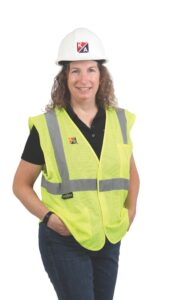 The faculty point person for the Nobel Hall expansion and renovation reflects on tending to it.
The faculty point person for the Nobel Hall expansion and renovation reflects on tending to it.
She wasn’t exactly the faculty “leader” on the Nobel Hall of Science expansion and renovation. She was more of a guide, a chaperone, an escort.
Call her the “faculty shepherd.” The Geology and Environmental Studies professor carried no crook, just a hardhat and a direct line to both the faculty and the building team. Based on Gustavus’s preliminary research and the recommendation of the architect on the project (Hastings+Chivetta, based in St. Louis, Mo.), “Science buildings that had a faculty member embedded in the process had better outcomes,” Bartley says.
What does a faculty shepherd do, exactly? “I handled things where the building touches the programs. I was a faculty voice when there was a question about infrastructure. I was the on-the-ground decision-maker, but also the link between the person who was going to use an area of the building and the builder’s and architect’s and contractors’ questions,” she says. Where does the sink go when a pillar needs to be moved? What kind of learning happens in this corner exactly? Bartley knew the answer, or who to ask for it.
She was also the connector, getting the right faculty in the room for certain meetings and keeping them updated on building progress, particularly as it related to their specific programs and spaces. “I made heavy use of a Nobel-wide listserv, which included everyone with an office or lab in the building, plus everyone involved in the project—from Gustavus Technology Services to Dining Service to Campus Safety.”
At the beginning of the project, Chemistry professor Scott Bur shepherded the faculty through the initial dreaming and design phase. Bartley took over when the build began.
A shepherd’s primary responsibility is the welfare of the flock. Bartley carried out that responsibility tirelessly. “It got to the point that one time I left Nobel Hall and got in my car and hit my hardhat on the car. I had no idea I still had it on.”